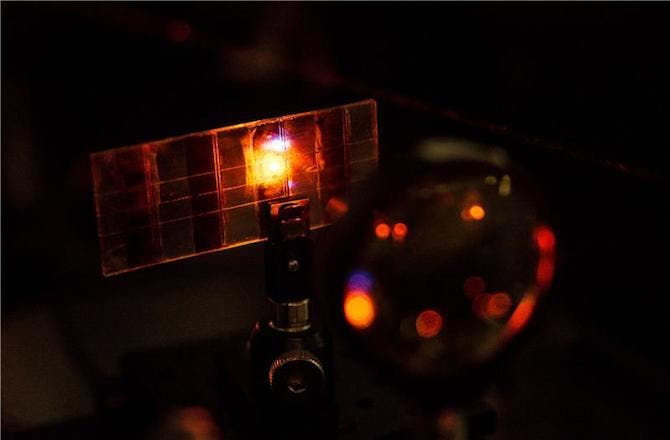
Scientists have made great efforts to discover a material that can be used to both absorb and emit light. A fluke may have suffice, since researchers at Nanyang Technological University (NTU) in Singapore discovered by accident a material that can be used to work as a solar panel, harnessing energy from the sun during the day, as well as a light panel during the night, emitting light with electricity is passed through it.
The implications could be major if the material can be integrated with existing technology. For instance, the smartphones of the future could charge just like a solar panel during the day by placing the display facing the sun, while still being able to display information. Other more immediate applications include advertising billboards that are less demanding and dynamic than consumer electronics (no need for touchscreen or complicated software). The mall’s of the future could have windows layered with this material, since it can be fashioned to be trans-lucid. The possible applications are numerous.
Solar cell at day, light panel by night
This solar cell is developed from Perovskite, a promising material that could hold the key to creating high-efficiency, inexpensive solar cells. The researchers discovered it dual use by chance after NTU physicist Sum Tze Chien asked one of his postdoctoral researchers to shine a laser on the Perovskite material. Since most solar cell materials are good at absorbing, not producing light, the research team was surprised when the Perovskite glowed brightly.
This is a significant finding as most solar cell materials are good at absorbing light but are generally not expected to generate light. In fact, this highly luminescent new Perovskite material is also very suitable for the making of lasers. Not only this, by tuning the composition of the material, when an electrical current is passed through the Perovskite material you can make it emit a wide range of colours, which also makes it suitable as a light emitting device, such as flat screen displays.
“The fact that it can also emit light makes it useful as light decorations or displays for the facades of shopping malls and offices,” said Dr Nripan Mathews, who is also the Singapore R&D Director of the Singapore-Berkeley Research Initiative for Sustainable Energy (SinBeRISE) NRF CREATE program.
“Such a versatile yet low-cost material would be a boon for green buildings. Since we are already working on the scaling up of these materials for large-scale solar cells, it is pretty straightforward to modify the procedures to fabricate light emitting devices as well. More significantly, the ability of this material to lase, has implications for on-chip electronic devices that source, detect and control light,” he added.
The discovery is important not only because of the material’s interesting properties, but also because its incredibly durable and can be up to five times cheaper than silicon to manufacture. Silicon is the de facto material of choice when solar cells are considered.
The findings were reported in the journal Science.






